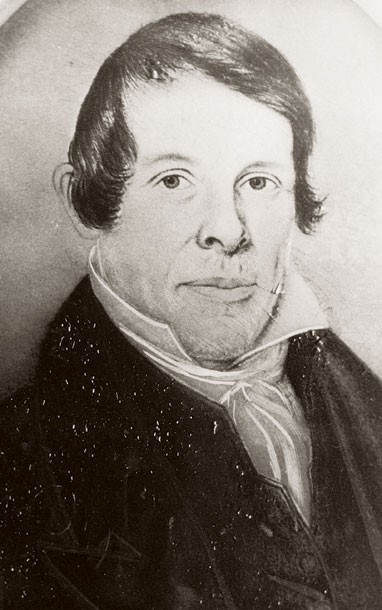
Miniature portrait, Jabez Vodrey, ca. 1827. Oil on copper. (Courtesy, the Vodrey family; photo, Helga Studio.) Probably painted as a keepsake for his wife, before he set sail for America in 1827.

Price List, Vodrey Pottery Works, East Liverpool, Ohio, 1864–1865. (Courtesy, East Liverpool Historical Society.) The term Queen’s ware outlived any resemblance to the thin creamware perfected by Wedgwood and made by Jabez Vodrey in Louisville. As perpetuated by Vodrey’s sons, William H. and James N., and by other American potters, the term “yellow Queensware” had by the 1860s come to mean a high-fired stoneware of a deep straw color, made from the refractory clays found between coal seams. Collectors today know it as “yellowware.” The addition of a transparent brown coating (Rockingham glaze) or splashes of color (variegated) seems to have added twenty-five cents to the price of a dozen pressed bowls. The earliest record thus far found of Rockingham glaze being made in America is dated 1843.

Pitcher, Frost & Vodrey, 1828. Yellow ware. H. 7". (Courtesy, Historical Society of Western Pennsylvania; photo, Helga Studio.) This pitcher was among the contents of a corner cupboard donated to the historical society in 1961 by Mrs. Frances W. Lane, a descendant of William Price, and was published many times as an example of midwestern manufacture. Not until the study of the Vodrey diary, however, did it become apparent that Frost & Vodrey must have been the potters who made it, and Sarah Vodrey, the decorator. Inscribed “Friendships Gift to Wm Price 1828,” its hand-painted scenes recall Price’s foundry, his round house, and his brief connection with the Fort Pitt Glass Works; an American eagle is emblazoned beneath his name under the spout.
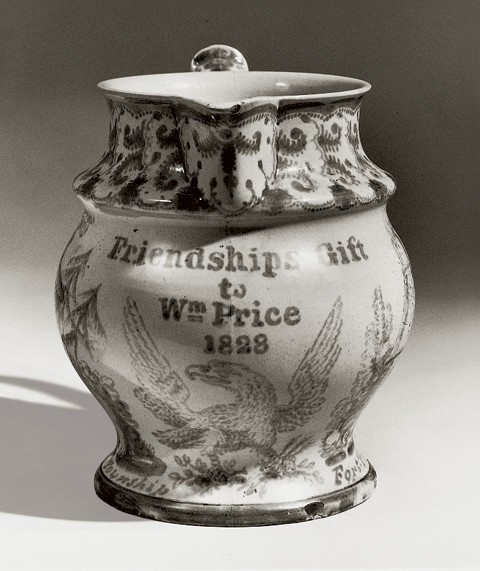
Front view of pitcher illustrated in fig. 3.
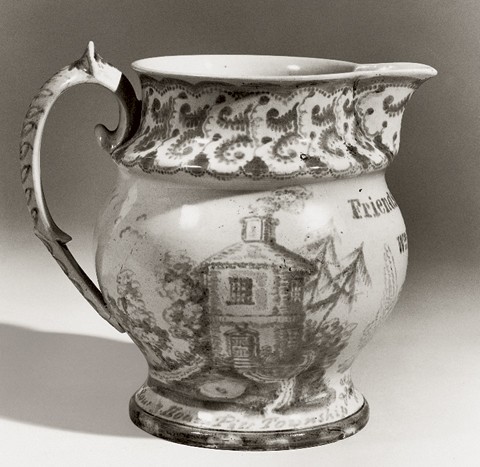
Reverse view of pitcher illustrated in fig. 3.
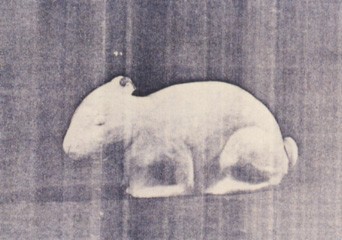
Photocopy of a rabbit figure attributed to the Lewis Pottery. (Photos, courtesy of the authors unless otherwise noted.) A Louisville resident remembered seeing this small white pottery rabbit in the collection of the Filson Club. About 4" long, it was a size that potters would have called a “toy.” When the authors
visited the collection, only an old 8" x 10" glossy remained in the file, inscribed on the back: “Photo of bunny made in the Lewis Pottery during the years of the pottery’s existence 1829–1836. Given by Miss Mary Lee Warren, Louisville, Ky Oct. 1948.” When the collection was revisited, the photo, too, had disappeared, leaving only this poor photocopy of the original to prove that the bunny ever existed.
The rabbit appears to have been press molded, with incised details at mouth and eyes, and given an applied tail. Its ears were broken. While there were some examples of press-molding found in the dig, there was nothing quite like the rabbit. However, the Vodreys did later have a pet rabbit for the boys—“to teach them tenderness,” Jabez wrote.
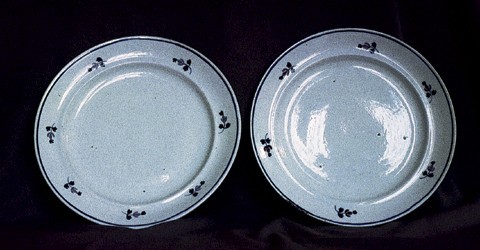
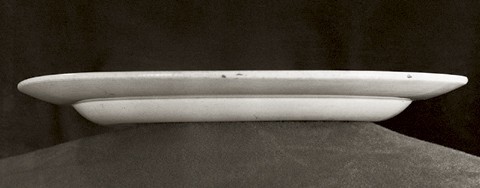
Profile of plate illustrated in fig. 7. (Photo, Helga Studio.)
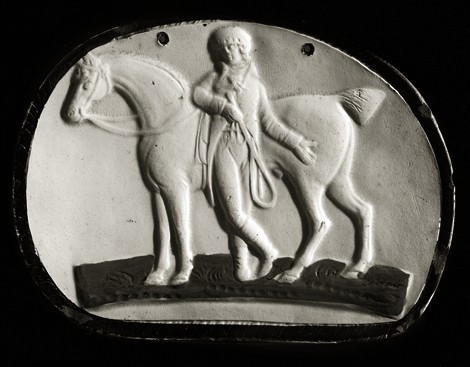
Oval plaque, Jabez and Sarah Vodrey, 1839. Whiteware. W. 5 5/8". (Courtesy, the Vodrey family; photo by Helga Studio.) A glazed white-bodied plaque, press molded with the standing figure of a man leaning on his horse, holding a riding crop in one hand. The patch of grass is painted underglaze in olive green; the incised “rope” edge is black. This type of figure is seen on many relief-molded Staffordshire pitchers, and may have appeared on Staffordshire-made plaques as well.
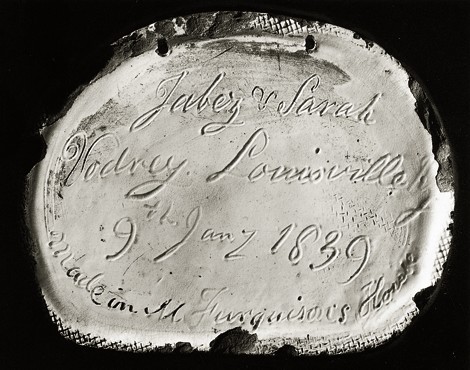
Reverse of plaque illustrated in fig. 9. Deeply incised on the back: “Jabez & Sarah/ Vodrey Louisville, Ky / 9th Jany 1839/ made in M Furguisons House.” Signed with the names of both Vodreys and dated only weeks before Jabez left Louisville to take over the management of the Troy Pottery, this plaque is the only irrefutable document of their work in Louisville.
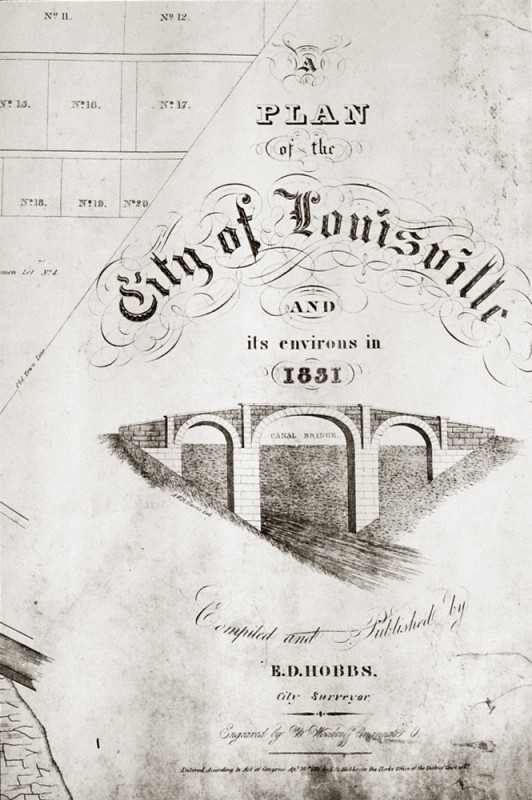
Title page from Plan of the City of Louisville And its environs in 1831. (Courtesy, Filson Club.)
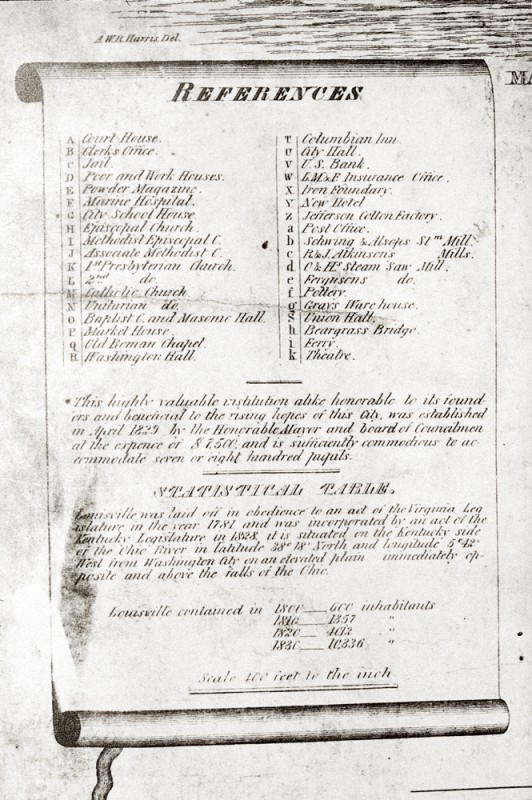
Location index to the Plan of the City of Louisville. The pottery is referenced as “f”. (Courtesy, Filson Club.)
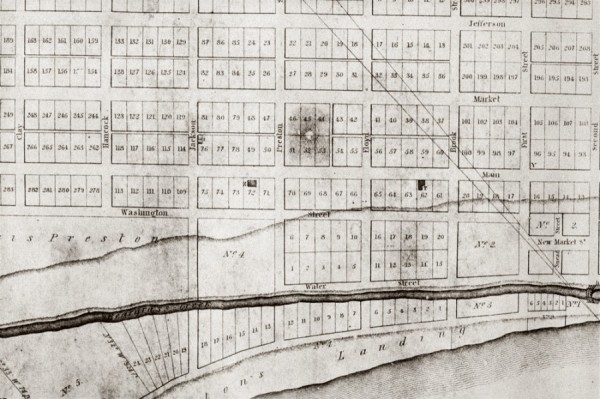
Detail of the Plan of the City of Louisville, showing the location of the pottery on Lot 76. (Courtesy, Filson Club.)

View of the Lewis Pottery site as an asphalt-covered parking lot.
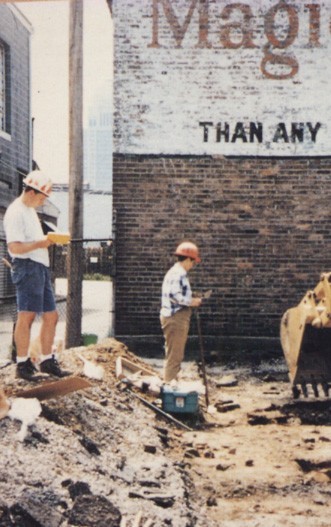
Site Director Kim McBride guides the backhoe operator in clearing the asphalt and modern overburden, while archaeologist Jay Stottman (left) maps the trenches.
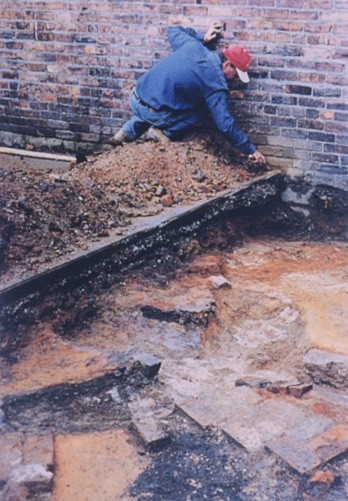
Archaeologist Bob Genheimer exposes remains of a kiln foundation.
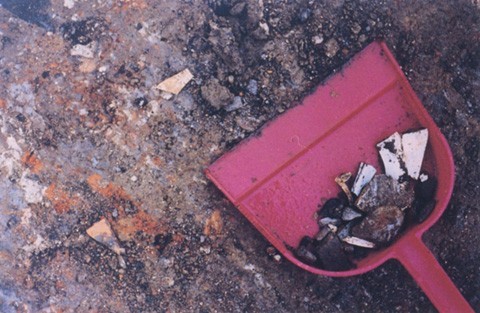
Artifacts were carefully separated by hand from potters’ clays kept moist in the earth, too viscous to be sifted.
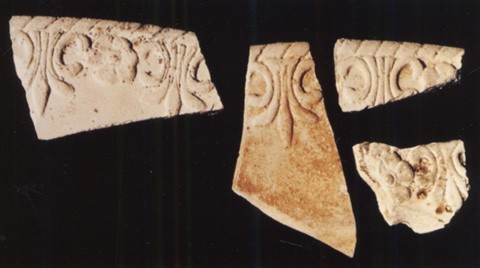
White-bodied, embossed-edge sherds, Lewis Pottery, 1829–1837. To be able to supply white plates, made from native materials, for the dinner tables of the nation was to an American fineware potter the pinnacle of success. And once Staffordshire potters began to export white-bodied ware shortly after the War of 1812, it became an imperative.
These four fragments of plate rims are certainly white bodied—despite the stains absorbed from being in the earth for 170 years—and proof that the Lewis Pottery did achieve that goal, unheralded though the company was. The details of the mold are sharp, and the rim design borrows liberally from the variety of embossed edges popular since the 1780s and still a favorite import in the 1820s and 1830s. They might well have been decorated with underglaze blue had they not been discarded. A two-line invoice for a small amount of calcined cobalt was copied into the Louisville pages of the diary:
Messrs. Lewis & Vodrey September 29th 1833
to 1/2 lb of Blue Calx $3.50
This seems outrageously expensive for such a small amount, but calx was a refined form of cobalt and such a potent coloring agent that it went far. Surprisingly, there was almost no evidence of blue decoration in what was found at the dig.

Plates, Staffordshire, 1820–1835. Pearlware. (Private collection; photo, Hans Lorenz.) Examples of embossed-edge plates trimmed in both blue and green made in Staffordshire and exported to the United States in huge quantities in the 1820s.
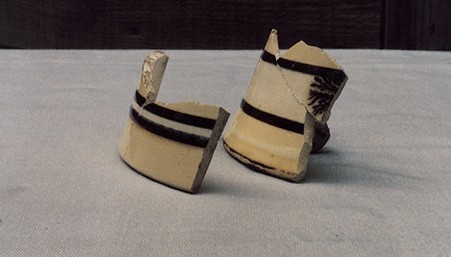
Rim sherds from London-shape “dipt” creamware bowls, Lewis Pottery, 1829–1837. One great challenge in ceramic archaeology is identifying the vessel forms; another, is accepting that this identification is never certain. When all the bits and pieces were washed, numbered, and recorded as to where they were found, they were sorted by glaze, color, texture, thickness—any visual means of grouping them. After these ceramic groups were transported to Cincinnati, Bob Genheimer’s corps of volunteers glued and assembled the hundreds of jigsaw puzzles. Then, aided by Vodrey’s own notes and accounts, by research into contemporary production here and abroad, by visualizing the invisible parts, by guess and by gosh, we reached conclusions—or we did not.
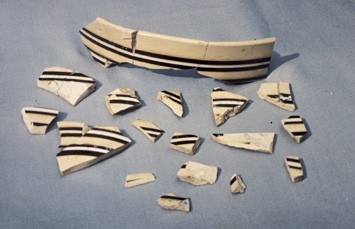
Sherds from cream-color bowls banded in brown and white, Lewis Pottery, 1829–1837. Twenty-five white-bodied sherds were glazed a cream color. They were from bowls of varying sizes and thicknesses and had differing sets of narrow brown and opaque white slip bands, each line 1/8" wide. The bowl above had a projected diameter of 8".
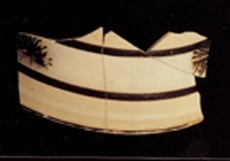
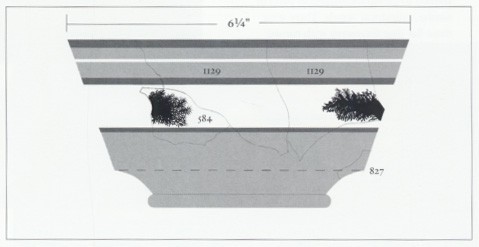
Projected drawing of bowl shape based on sherds illustrated in fig. 22. (Drawing by Diana Stradling.)
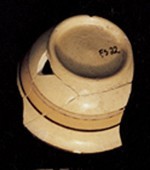
Cup, Lewis Pottery, 1829–1837. Cream-colored banded in brown and white. H. 1 3/4". Four large sherds, all apparently clear-glazed with very fine crazing, over a cream-colored body, assembled into an S-curved teacup, the flaring rim thinned at the edge. A small hole between the sherds indicates where a handle may have been attached. Decorated with bands of colored slip, the lower line of brown glaze has completely peeled away, perhaps because it was applied onto the tan slip and not directly onto the body. The shape of the cup, with a different handle, can be found among the early numbers—131 and 136—in the first pattern book of W. Ridgway & Co., a firm established early in 1831. Vodrey must have adapted the shapes he admired among the imported Ridgway designs he had seen at Mr. Kerr’s “house of splended ware from Allcocks, Ridgeways,” which he wrote about in 1836. The Kerrs later operated a “China Hall” in Philadelphia at the time of the Centennial in 1876, at 1218 Chestnut Street, and another in Ireland.
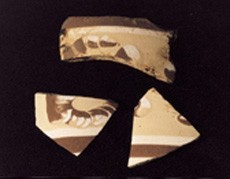
Sherds, Lewis Pottery, 1829–1837. Slip decorated in Common Cable pattern. A total of thirteen small sherds, all biscuit- and white-bodied, are in this group; one or two have marbleized slip and some are feathered at the edges.
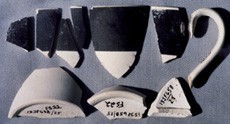
Fragments of cylindrical mugs, or canns, Lewis Pottery, 1829–1837. H. 2 1/2". Nine white-bodied biscuit sherds seemed to group themselves as parts of similar, cylindrical vessels. There were three flat base fragments with turned footrims, wall fragments that were vertical when stood on their rims, and one molded handle. A wide band of brown slip had been applied to the walls, then had been shaved flat and smoothed, the turner’s tool leaving traces of horizontal scoring. The upper terminal of the white handle had brown slip adhering to it, and a corresponding lack of slip on a rim fragment revealed its probable location; a shallow flake out of a base was probably where the lower terminal had been attached. From these observations, an overall measurement of the vessel could be projected.
Mugs of a similar size and shape were designated “square chocolates” by Leeds and other English potteries. Vodrey’s odd choice of decoration—the broad band of brown slip on the white body—suggests that he may have had this function in mind for these cups.

Newspaper advertisement for the Pittsburg Pottery, 11 February 1815. (Courtesy, American Antiquarian Society.) Chocolates, mugs, and cups, but no saucers or plates, were being made by Alexander Trotter. An ambitious potter, he left Philadelphia to form his own company but his western venture succumbed to bad times after the end of the War of 1812. By 1819, he had moved again to try his luck in Baltimore.
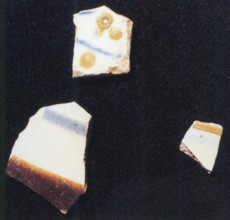
Sherds from unidentified vessels, Lewis Pottery, 1829–1837. Whiteware. The only traces of blue found on fragments at the Lewis Pottery site appeared on these tiny sherds. The dollop of yellow-green had a burst bubble in its center. Many had a smooth, opaque enamel-like surface.
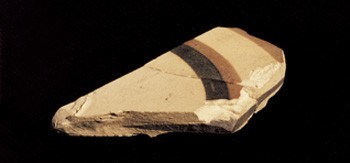
Unglazed lid fragments, Lewis Pottery, 1829–1837. There were three intriguing sherds each with a layer of black clay embedded at the core. In one, the1/16" thickness was so consistent and precisely centered between cream-colored layers that it appeared to be a deliberately placed lamination. However, in the two assembled pieces shown above the black layer wobbles in thickness, and does not extend to the edge, or to the center of the lid, where an empty crater marks the spot where a finial had blown off during firing.
Opinions vary about the cause or intent—one expert suggesting that clays with different expansion rates might have been utilized to counteract a tendency to warp; another, that the black layer is the result of bloat caused by accidental conditions in the kiln.
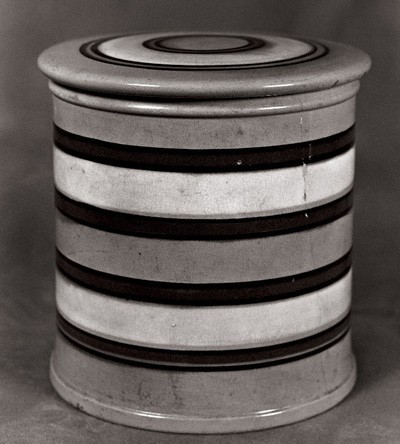
The lid illustrated in figure 29 bears a strong resemblance to the family’s “cookie jar,” believed to have been made by Jabez at a somewhat later date, possibly in Troy. Interestingly, its large, flat lid was made without a finial.
Two similar, smaller jars in the East Liverpool Museum of Ceramics have been attributed to the East Liverpool pottery of Vodrey & Brother in the 1860s. These jars were also made without finials.
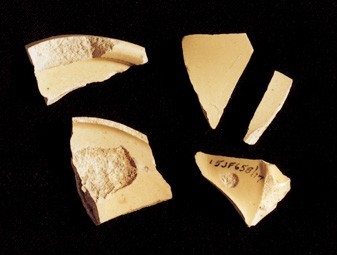
Sherds from salve jars, Lewis Pottery, 1829–1837. Five fragments that appear to be from ointment pots or jars of a yellowish enamel-type glaze. One retains an arc of a foot ring; another interior piece retains a bit of the vessel wall. A druggist named Peter Gardner was listed in the Louisville City Directory for the Year 1832 “at Mr. Lewis; s[outh] s[ide] Main b.[etween] Jackson and Preston.” This explains the finding of small round jar fragments found among the pottery wasters. Gardner probably had his pharmacy in the pottery store that was located on the side of the Lewis property. There were no subsequent directories until 1838, and he is not listed again.
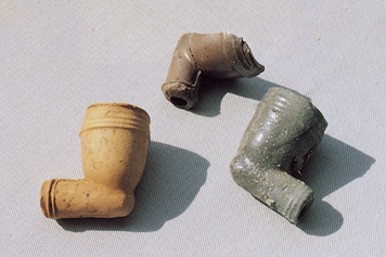
Tobacco pipes, Lewis Pottery, circa 1815–1840s. Earthenware and stoneware. Tobacco pipes were everywhere on the lot. Some were complete, but most were in pieces; some were warped, and some all but melted; some were saltglazed stoneware, redware, even yellow ware—mementos of every potter who ever worked the site. All were the short, stubby shape typically found in American archaeology in date contexts through the late nineteenth century, the kind that were meant to have a stiff reed stem inserted into the stub.
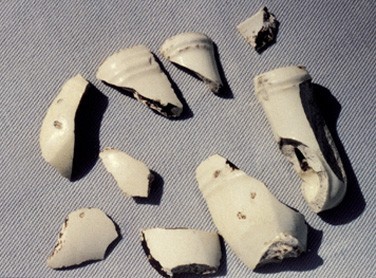
Tobacco pipes, Lewis Pottery, 1829–1837. Whiteware. There were no white biscuit earthenware pipes and no long stems, broken or otherwise, of the sort still being imported from England. But there were, scattered throughout, white-bodied pipes with a longer bowl shape than all the others, which had an innovative ivory white glaze—smooth and opaque, like that found on some of the decorated sherds at the site—and these had to have been made by Vodrey. We know that by 1838 Vodrey was experimenting with marbled and painted pipes, the latter being decorated with underglaze color. In 1839 he was selling plain and marbled pipes at $1 per hundred, while painted pipes were at $1.50 per hundred. He had been making pipes since his arrival in Pittsburgh in 1827 and to him they were something of a bread-and-butter line. They were priced by the hundred but were often shipped by the barrel, as many as five thousand at a time. In constant demand, they represented a steady income to the potter.
We have lived with the spirit of Jabez Vodrey for a very long time. Little did we realize, when we traveled to East Liverpool, Ohio, to see the diary (still carefully preserved by descendants) of this early American potter, that we were about to embark on a lifetime of research.
By now we probably know more about the world of Jabez Vodrey than about our own. Born in Staffordshire, England, in 1794, Vodrey apprenticed in Tunstall and married Sarah Nixon there. He then went with William Frost to Derbyshire, where they worked for Joseph Thompson, who in 1818 had established the Hartshorne, or Wooden Box, Potteries between Burton-on-Trent and Ashby de la Zouche. They emigrated together to Pittsburgh in 1827 and relocated to Louisville, Kentucky, in 1829, where the Vodreys’ three sons—William, James, and John—were born. Vodrey managed the Indiana Pottery Company in Troy, Indiana, from 1839 to 1847 and then moved on to East Liverpool, Ohio. His sons continued his trade long after his death there in 1860, becoming prominent manufacturers in the town hailed as the “Staffordshire of America.”
The diary was really a “commonplace book,” full of jottings, gleanings from newspapers, batch recipes, accounts, nostrums, and weather reports. Vodrey’s recollections, written sometimes years after the event, provide insights into an earlier time. Begun in earnest in March 1839, when he was managing the Troy Pottery, the diary was a way of teaching his son William not only to write but to take pride in his daily accomplishments; it is a mine of information about his craft and about life in America. When we first read the diary, large sections had already been transcribed and typed by secretaries who struggled valiantly with the nineteenth-century script, correcting spellings as they went. “Diphtheria” became “dry heaves” and “druid snip” became “dread ship.” The American Ceramic Circle agreed to publish the diary if we would properly transcribe it. This accomplished, we all agreed it had to be annotated or no one would understand the verbal shorthand, the language of the trade, or even the casual references to daily life on what was in every way, a different planet than the one we occupy today.
At the city’s historical society, the Filson Club, we found an 1831 map of Louisville which showed the Lewis Pottery, where Vodrey had worked, on Jackson Street near the corner of Main. The location of the pottery was also bounded by an alley that traversed several blocks. Once the scene of many a goat race, it was named, appropriately, “Billy Goat Strut Alley.” When visiting the lot, we found that two large buildings stood within its original boundaries, but just on the spot where the map pinpointed the location of the Lewis Pottery, there was now a parking lot.
The answers to many of our long-standing questions seemed close at hand. Did Vodrey actually make the two thin, cream-colored plates that had always been attributed to him? Did he make the white rabbit seen only in an old photograph in the archives of the Filson Club? The family still had a tantalizing white-bodied plaque that Jabez and Sarah had signed in 1839, evidence that they could indeed have made these things. Only a thin layer of asphalt, already sinking from the weight of cars and trucks, stood in the way of discovery.
The Queen’s Ware Challenge
“Queen’s Ware” was the term coined by English potter Josiah Wedgwood, sometime between 1765 and 1767, to tell the world that his cream-colored earthenware had obtained royal patronage. In 1779 he began to produce another type of ware (made whiter by the addition of bluing in the glaze) that he called “Pearl White,” known today as “pearlware.”[1] These achievements established standards of quality against which fine earthenware potters everywhere measured their success.
Emboldened by embargoes banning British imports before and during the War of 1812, American businessmen rose to the challenge and tried to replace English fineware with their own homemade dishes for the nation’s tables. While the results of their efforts in the East, especially in Philadelphia, have often been described, less has been written about ventures west of the Allegheny Mountains, where as early as 1806 Samuel R. Bakewell announced that “Delft Ware” would soon be available from his pottery in Charlestown, Virginia.[2]
Shortly thereafter in Pittsburgh, William Price, who had come from England as a glassmaker, was manufacturing white clay smoking pipes. Apparently he also tried his hand at tableware: in the 1811 edition of The Navigator, Zadok Cramer reported, “Mr. William Price has attempted the making of ‘delf’ ware, and has produced some handsome specimens.” Complaining that the cost of cartage from the Atlantic seaboard made western customers pay twice as much for tablewares as customers in the East, he added, “It would indeed be something handsome could we stop those hundreds, nay thousands of crates of ware from coming over the mountains, in which every man who eats off a plate is taxed one hundred per cent.”[3]
Potters in Europe had long known that a coarse or discolored earthenware body could be successfully coated with a white enamel of glass and oxide of lead opacified by 2 or 3 percent of tin oxide to make what they variously called delft, faience, or maiolica.[4] Most potters in America, however, were trying to replicate the popular English wares, in which a white body was coated with a transparent or translucent lead glaze. This process required finding kaolin or a white-burning ball clay, and enough of it to make its use commercially feasible—which was only the first problem.[5]
Even potters trained in Staffordshire were unnerved to find that American ingredients would not behave like those at home, where such substances as “Cornish stone” and “Devon clay” were tried and true. Some bodies were stained by iron inclusions while others refused to hold a glaze, necessitating endless experiments that led to frustration and, ultimately, to compromise. For American manufacturers, the term “Queen’s ware” represented what they hoped to make but eventually came to mean whatever they actually made, regardless of appearance, so long as it might possibly pass for English. In 1815, nine persons in Pittsburgh were reportedly employed in the manufacture of “yellow queensware,”[6] but the fledgling queensware manufacturers of the West were doomed before they got started.
Not long after the end of America’s second war with England (December 1814), cheap merchandise began flooding into American ports.[7] On May 6, 1815, the Kentucky Gazette reported: “A boat loaded with QUEENS WARE, passed Steubenville the 19th ult. on its passage from New-Orleans to Pittsburg. The carriage will be lower than the lowest waggon carriage from Philadelphia to the same place, and no risque of breaking the ware.”[8] For Pittsburgh potters, the sight was devastating.
Merchandise hardly ever came upstream from New Orleans, not only because of the torturous trip against the current, but because the Falls of the Ohio at Louisville, Kentucky, brought all northbound river traffic to a halt. Upon reaching Shippingport, Kentucky, below the falls, cargo had to be off-loaded, portaged to Louisville, then reloaded onto other boats to continue its journey. Even southbound, the solid rock formations, two miles long with a drop of twenty-two feet, were passable only during high water—in spring and fall—when three channels or chutes allowed local pilots to guide vessels on a one-way journey over the falls.[9]
The United States Congress moved to protect the nation’s infant industries by passing a comprehensive tariff act on April 27, 1816. As of June 30, a 20 percent duty would be levied on “china ware, earthen ware, stone ware, porcelain and glass manufactures other than window glass and black glass quart bottles.”[10] However, these monetary handicaps did little to counter the long terms of credit offered American merchants by Staffordshire potteries or their discounts, as much as 28.8 percent on “C.C.” (originally denoted “cream-colored”) wares.[11] The tariff was too little and too late, as the nation slipped into a deep financial depression that would come to be known as the Panic of 1819. One by one, the fires of western industry went out.[12]
That Americans were experiencing financial hardships failed to dissuade the Staffordshire potteries, which during the early 1820s came up with a new type of tableware. Entire services were introduced transfer-printed in dark blue with American scenery and important events in American history, such as the one titled “The Landing of Gen. Lafayette at Castle Garden, New York, 16 August 1824.” Even American triumphs over the British in the War of 1812, such as Commodore MacDonnough’s victory at Lake Champlain, were depicted on showy dishes aimed at the American market.[13]
It was not until the presidential campaign of 1823, amid the fervor for the “American System” drummed up by presidential candidate Henry Clay, that any western entrepreneur dared to consider making queensware again. Among the first was Jacob Lewis in Louisville, Kentucky. From western Pennsylvania, the son of a surveyor, Lewis had built the town’s first stoneware pottery in 1815, located on the corner of Main and Jackson Streets.[14] He found Louisville to be the perfect place from which to sell his utilitarian salt-glazed crocks, pitchers, and churns. The market area was the Ohio River and its tributaries, and extended north to Cincinnati, west to St. Louis, and as far south as Alabama and New Orleans.[15] By 1823, he felt the time had come to put American-made dishes on American tables. When merchant W. L. Thompson was about to depart for Philadelphia, Lewis gave him a sample of clay to be tested at a queensware pottery there, but Thompson found the pottery had been “given up by the owners.”[16]
In his next attempt, Lewis gave clay samples to Louisville tobacconist Charles Whittingham to be tested when the latter went to England in 1825, but Whittingham never got to the Staffordshire potteries. Instead he passed the samples along to someone else, who reported back that the clay sample was not large enough to be fully tested, but the preliminary results were quite favorable.
In Pittsburgh, William Price had come up with the same idea as Lewis. His neighbor, George Hatfield, recalled in later years, “Among the enterprises engaged in by William Price, was the manufacture of white clay tobacco pipes, he using German clay for the purpose. He afterwards experimented with a clay found in or near the city, and succeeded so well that he was led to suppose good earthenware could be made from the same.” For this reason, Mr. Hatfield said, Price had traveled to England and convinced William Frost and Jabez Vodrey to return with him, “bringing the necessary tools and machinery to enter upon the manufacture of white ware.”[17] Both were Staffordshire men who had been working in Derbyshire for the past seven years.[18] Frost, a thrower, formed the ware on the wheel; Vodrey, a turner, trimmed and finished the piece on a horizontal lathe. Both skills were essential to the production of fine English earthenware.
The Pittsburgh newspaper, the Commonwealth, reported the following on December 27, 1827:
Queensware Manufactory.—We are gratified to learn that an establishment for the manufacture of Queensware, will be in full operation in the precincts of this city, in the course of a few weeks, Messrs. Frost and Vodrey are the proprietors. They state that all the material for the manufacture of their work can be had in Western Pennsylvania and some of it on or near the premises....Some of their work is what they call the biscuit, or unglazed state, which are creditable specimins of the quality of ware they will be able to manufacture.”
The two potters soon realized that they could not find enough good clay near Pittsburgh to produce whiteware on a commercial basis. Vodrey, however, kept some small examples of wares made there until a fire destroyed them more than twenty years later. On March 10, 1849, he wrote in his diary, “I first used the Indurate clay in Pittsburgh 1827. It was the cleanest and whitest clay Picked from a Keel boat load brought from King’s Creek near wheeling. Pieces of ware glazed with 15 per cent of this clay to glass and lead with a little tin have stood without crazing up to yesterday morning, when their loss was regretted very much.”
George Hatfield recalled, “The clay here was not suitable for either white or yellow ware, and they drew their supplies for manufacturing the latter kind from the neighborhood of Perryopolis on the Monongahela river.”[19] Here, a similar clay to that which Vodrey had used in Derbyshire was found between layers of coal.[20]
Hatfield added, “On market days, Frost and Vodrey could be seen trudging through the mud toward the market house, each with a basket of ware on his back, all of which they sold before nightfall. They made pitchers, bowls, vegetable dishes, plates, cups, saucers, egg cups—everything in the line of earthenware, in fact, and made it well.”[21]
When George Hatfield’s recollections were published in 1879, he had in his possession a covered dish, ordered from Frost and Vodrey as a gift for his wife. Inscribed on its top was “E. Hatfield, February, 1829.” Hatfield explained, “The wife of Jabez Vodrey was the ‘decorator’ of the establishment, and would, when desired, put the names of the purchasers on their dishes. She used blue for this work.”[22]
In 1828 Jacob Lewis had discovered what he believed to be an excellent source of kaolin in Missouri. When John P. Bull—partner with Samuel Casseday in selling imported queensware, glass, and china—was about to embark on a business trip to England, Lewis gave him samples of the clay to have tested at the Staffordshire potteries. Bull later reported, “I had a small pitcher made of it: it was mixed up and made in my presence, and marked with my name on the bottom: it was finished and sent on with other ware. It can be easy seen that the quality is finer than the English ware. I gave it to Mr. Lewis when it arrived in 1829.”[23]
With enough evidence in hand to convince Louisville merchants they should invest in a queensware company, Lewis increased his efforts to find qualified potters to run it. According to Jabez Vodrey,
In 1827, Mr. William Frost and myself commenced a fine ware pottery in Pittsburgh, but could not procure clay to make white ware. In the spring of 1828, we received a letter from Jacob Lewis, informing us that he could furnish clay for white ware; and in August he came with several samples of clay that burnt white; we made him a small lot of ware out of it. In December following he brought more for us to try. In the spring following he came twice and we agreed to go with him to Louisville in the employment of the company.[24]
On December 15, 1829, the “Lewis Pottery Company for the purpose of manufacturing Queensware and China at Louisville” was incorporated by an act of the Kentucky legislature. Two hundred shares of stock were issued at five hundred dollars each, though the number actually sold is unknown.[25]
In 1830 Anne Royall, the nation’s first famous female journalist, was traveling on her “Southern Tour” and dropped in at Louisville. Leaning over the boat rail to get a better look as she approached the town, Mrs. Royall was relieved of her small roll of banknotes. “Such is the grandeur of the entrance into Louisville from the point we approached that I might have been robbed of every thing I owned,” she wrote. “Louisville stretches along the Ohio upon a plain of three miles, with handsome streets paved on the McAdams plan. The houses are elegant fresh brick buildings—the air of wealth and business, the Ohio river, the fertile state of Indiana on the opposite shore with Corn Islands, the roaring falls and the splendid canal is quite imposing. It is the handsomest town by far I have seen on my tour, and does an immense business.”[26]
The canal mentioned by Mrs. Royall was being completed around the Falls of the Ohio. “It is about two miles in length, the whole of it cut through solid rock of the hardest kind. It is so wide and deep to see it now, that one would think it impossible to be the work of man. It is 300 feet wide at the top, and 24 feet tall, 12 deep, with two bridges of solid stone containing 5741 perches of masonry, and has 4 locks, the masonry of these locks is superior to those of the grand canal, and doubtless the best in the world. There were 500 hands at work, and every one seemed to work for his life. This canal met with much opposition which I was surprised to hear; but it is done now, and will doubtless last to the end of time. It is intended for the passage of the largest vessels.”[27]
Intrigued by the progress being made in Louisville, Mrs. Royall took the time to visit the new pottery. “The queensware factory belongs to a Mr. Lewis, a very clever and intelligent man,” she wrote. “I saw several pieces of the ware, but they have not gone fully into business, for want of glazing and workmen acquainted with that part of the business—for which I understand he had sent to Europe. The pieces I saw were of a dull white and very smooth.”[28]
By Jabez Vodrey’s own admission, “We did not succeed in making all good ware in the first attempt of new materials. The company became discouraged and all of them abandoned it except Mr. Lewis. He continued and saved it from being lost to the State and country.”[29]
In December 1830 a letter was dispatched to William Ellis Tucker who had established a successful porcelain manufactory in Philadelphia in 1826. The letter offered five thousand dollars if Tucker would bring his talents to Louisville and reorganize the Lewis Pottery. Tucker mistakenly believed the offer concerned the establishment of a new porcelain factory and initially was not opposed to the idea. When he eventually realized the object was to produce “Queens Ware,” he refused the offer. In conveying the bad news to Jacob Lewis on January 22, however, William’s father, Benjamin Tucker, added a few words of encouragement and also of caution.
From the description thou hast given of your Clay, it is much to be wished that you may succeed, as it would not only be an individual but a national benefit—And in order to arive at the object; permit me to say, as you are yet unacquainted with the process of making a perfect ware, experiments upon a limited and economical scale will be much the most likely to succeed—These may be repeated without producing discouragement; And, if you can get a good body & a glaze to seal it; you need not be concerned about getting workmen to perform many of the other processes; the enterprising genius of Americans, if they are called in, at a proper age, will furnish you with equally excellent, and much more confidential work men than you can generally speaking, obtain from Europe—Some of the apprentices that my Son has brought up under his own hand fully verify this statement—The hostility and intrigue which many of his foreign work men displayed, proved highly injurious to his interests....A few good European workmen you will necessarily want in order to instruct American youths—And these by entrusting some confidential individual in Europe to send them out, might I should suppose be obtained.[30]
Several months later, Jacob Lewis submitted a sample of ware to the scrutiny of George D. Prentice, editor of the Louisville Daily Journal. An ardent supporter of the American system and biographer of Henry Clay, Prentice was only too happy to give the enterprise some publicity. The following appeared on April 28, 1831:
QUEENSWARE—We were favored yesterday with some specimens of Queensware, manufactured at Mr. Lewis’s Pottery in this town. They w[e]re really very handsome articles, and as we believe Mr. Lewis is the first man who has attempted the introduction of this species of manufacture in this country, we sincerely hope he may meet with a patronage commensurate with his skill and enterprise.
To this was added an appeal from Lewis:
STAFFORDSHIRE POTTERS
POTTERS, that can work on fine Ware on the Staffordshire plan, will meet with employment at Lewis’s Pottery.—flat and hollow Ware Pressers are much wanted.
Printers inclined to favor manufactures in our country, may promote the interests of it by giving this notice a few insertions in their papers.
Creating a pottery on the Staffordshire plan was ambitious. It was the beginning of the “factory system,” whereby certain tasks were assigned to specialists, rather than two or three men who performed all jobs. Failing to attract the sort of skilled workers he required, Lewis turned to offering potters an interest in the business. The following appeared in the Washington Intelligencer on October 21, 1831:
NOTICE.
TO STRAFFORDSHIRE POTTERS.A FINEWARE POTTERY has been established in
Louisville, Kentucky; and the Ware made is of a superior quality; the sound, or ring of it, is more like glass or china than common imported ware; it stands hot water and change of temperature without injury. Fineware Potters in every branch of the business (of good habits) can have an interest in the business on advantageous terms. The cost of materials for making the ware are favorable, when compared with the cost of them at the manufactories in Europe, and the necessaries of life are much cheaper at this place.
Letters postpaid will be duly attended to, by
oct 21—3t JACOB LEWIS[31]
In 1832, Jacob Lewis somehow managed to effect a reorganization of his queensware pottery. A new glost kiln was to be constructed and Jabez’s brother-in-law George Nixon, “a fineware thrower,” was taken in as a third partner with Vodrey and Lewis to run the Lewis pottery for the next five years. Under an indenture signed in June, which made no mention of William Frost, Vodrey and Nixon were to have two years’ free rent, after which they would have to pay no more than three hundred dollars per year.[32]
There was already clay on hand, estimated at ten and one-half tons, and unburnt and unfinished ware. All expenses for this clay and the glost kiln, which was about to be completed, were to be shared equally, as were the profits, from which each party was “to draw an equal amount of money every Saturday night, after meeting the running expenses of the week.” No workmen were to be hired who were unacquainted with making fineware on the Staffordshire plan. The partnership would be known as the “Lewis Pottery,” whose name would appear on all billheads and the ware “marked in a like manner.”[33]
The role of each party to the agreement was specifically defined. Jacob Lewis was “to give his attention to the out door business, that is to laying in the materials, and making sales of ware at wholesale, making out bills &c and to assist in keeping the sales book for the Pottery,” a role he had probably performed from his earliest days in the business. Vodrey and Nixon were to help apprentices acquire the skills of turning and throwing and to superintend all aspects of creating the ware. Bills for ware sold for cash were to be entered into a daybook at the time of delivery and carried into a ledger. Vodrey and Nixon would also be required to maintain a work book with daily entries describing amounts of ware sold and on hand, all expenses, and any debts due the pottery.[34]
There was, however, a clause in the five-year agreement that anticipated possible relocation of the pottery away from Louisville. If it was “deemed advisable before the expiration of said term to remove the pottery to a place where materials can be procured at a lefs expence, and with more cirtenty, they will try to purchase a situation and improve it jouintly for a Pottery.”[35]
During the next two years, most of the problems of the past were overcome. Perhaps Lewis, along with Vodrey and Nixon, had paid heed to Benjamin Tucker’s admonition to conduct experiments upon a limited and economical scale until success was achieved. William Frost was again identified as among those working with Vodrey and Nixon, and different clays, glazes, and decorating techniques were incorporated into the manufacture of a variety of wares.
Between May and the week of August 10, 1833, at least one other unnamed journeyman worked a total of fifty-three and one-half days, at $1.25 per day, a respectable wage for the time. Starting with a six-day week, he worked an ever-decreasing number of days until he was down to one or one and one-half days a week. Finally, settling his account on August 16, he went oV “down the river.”[36] Whether this decline in his workdays reflected waning sales at the pottery or intemperance, which was an occupational hazard of potters at the time, is impossible to judge. Unfortunately, there is no surviving record of the pottery’s output to help gauge its success. However, an 1834 invoice for crockery was found among the Vodrey papers. It includes large and small urns, three sizes of bowls, chamber pots in two sizes, nests of jars with covers, and two sizes of mugs.[37]
The canal surrounding the city had been completed in 1833. The new watercourse, enabling even the most colossal steamboats to bypass the Falls of the Ohio, caused a wrenching change in the way commerce was conducted in Louisville. Previously, numerous companies had concerned themselves entirely with receiving and forwarding the vast quantities of merchandise and produce destined for points on the waters above or below the Falls and throughout the West: now these companies had to think about making or selling products themselves.[38]
Although the pottery was not showing much profit, it was at least paying for itself, and Jacob Lewis was able to gather the signatures of more than fifty of Louisville’s most prominent businessmen onto a petition to the United States Congress. Dated May 14, 1834, it read: “Praying that a preemption right to a tract of land be granted to Jacob Lewis for the establishment of a manufactory of fine earthenware, &c.” further down the Ohio River or on the Mississippi—this petition was a first step in the foundation of a pottery center that would one day compete with and rival those in the towns of Staffordshire.[39]
On July 17, 1834, Jabez Vodrey became a citizen of the United States of America. On September 29 of the same year, William Frost was naturalized.[40] When the congressional petition, which had been referred to the Committee on Public Lands, was rejected that fall, the hopes of Jabez Vodrey, who had contributed a testimonial, dissolved along with Jacob Lewis’s dream.
The Louisville Directory for the Year 1836 lists “Lewis’s Pottery” at its familiar location on Jackson Street, at the corner of Main, but “Vodry’s Pottery” appears for the first time on the north side of Main between Hancock and Jackson. Residential listings for both Vodrey and Frost, however, remained on Lewis’s property. There were no other potters listed.
Apparently, Vodrey and Frost had moved across the street to a recently vacated stoneware pottery, where they continued trying to make fine earthenware, but Vodrey, obviously discouraged, was thinking of selling imported wares. From what must have been the depths of depression, he wrote to a brother-in-law in Tunstall, Staffordshire, England, noting that “a Mr. Kerr has lately opened a la[r]ge house of splended ware from Allcocks, Ridgeways.” He suggested that “if it is in your power to send us ware on credit we could pay the cost to this place and remit you money as we sold out.”[41]
But the dream of creating an American pottery center had not died. In 1836, Samuel Casseday, now running his queensware store in partnership with Willis Ranney, invited the British potter James Clews to come to Louisville with the idea of establishing a substantial fine earthenware manufactory nearby.[42] No doubt Casseday was unaware that James Clews and his brother, Ralph, had, in November 1834, gone bankrupt in England for a second time.
Clews scouted the surrounding territory and decided that, based on the presence of suitable clay and coal, the best place to establish a pottery on the Staffordshire plan was near Troy, Indiana, some seventy miles down the Ohio from Louisville. Here, in the spring and summer of 1836, Samuel Casseday purchased two parcels of land, totaling fifty-six acres. In December, as buildings and kilns were being constructed, Clews sent abroad for thirty-six potters to run the new enterprise. The cost of bringing these workers and their families to America was advanced by Ralph Clews to his brother James in the amount of $2,700. On January 7, 1837, the Indiana Pottery Company was incorporated by a special act of the Indiana legislature. It was capitalized by stock issued at a total of $100,000, owned in shares by eleven partners, including Clews, Casseday, and Jacob Lewis.
The first kiln of ware was drawn at Troy in June. According to local tradition, Clews was an arrogant and demanding master and the English potters he had brought to America were discontented. He had also hired “workingmen from Baltimore...filled with the spirit of freedom and Americanism. They believed they were as good as any men on earth and that they didn’t have to bow to any man because he was their employer.” Soon the potters were refusing to lift their hats or to bow when Clews passed them at the pottery. The English potters were also uneasy in their rustic surroundings; they began to abscond, some returning home, others finding work elsewhere in the United States.[43] Meanwhile, Jacob Lewis’s bad luck continued as the country plunged into the Panic of 1837.
On January 4, 1838, the directors of the Indiana Pottery Company, which had been in existence for scarcely more than a year, petitioned the United States Congress for a donation of public land containing the raw materials needed by the pottery. Stating that they had already spent fifty thousand dollars to put their manufactory into operation, they said it would be “impossible ever to make the business yield a profit until workmen can be made of American citizens.” They would, therefore, have to “pursue this business at a heavy loss for several years to come” unless they could obtain the “clay, marl, flint, spar and other materials necessary for the manufacturing of queensware and china...found, generally on poor and broken public lands” in Indiana, Illinois, and Missouri.[44]
James Clews left shortly after this petition was denied, and early in 1839 the Indiana Pottery Company hired Jabez Vodrey to manage and revive its pottery in Troy. By that time, Jacob Lewis had used up both his credit and his credibility in Louisville and could see no further business prospects there. He had heard that land formerly occupied by the Chickasaw Nation in the western part of the state was being made available to settlers practically free of charge. Toward the end of the winter he boarded a steamship and traveled west to take a look. In June he filed claims for three lots on the Tennessee River and by year’s end he was living in Hickman, Kentucky, and about to open a wood yard.[45]
During the summer of 1856, Jacob Lewis died at the age of eighty-three. No likeness has survived to allow us to study his face, but he must have been a charming and persuasive man. Never possessed of money or means, he was an entrepreneur nonetheless. An eternal optimist, he got along with the potters who worked for him and found ready investors for his various schemes. Though less than skillful in managing his finances, Lewis was probably no worse a businessman than the majority of his contemporaries at a time when manufactories rose with prosperity and crashed with depressions. He had given Louisville its first stoneware pottery and its first fineware manufactory. Yet, in the end, his most enduring legacy may have been his great-grandson, for whom the pride of Louisville, the Speed Museum of Art, was named—James Breckinridge Speed.[46]
Archaeological Research
In 1994 Gary returned to the site of the Lewis Pottery with archaeologist Bob Genheimer, who walked over to the alley and poked around a telephone pole with a stick. A comparatively recent feature, the pole had been sunk deep into the very earth we wanted to examine. Bob straightened up and handed Gary a chunk of sagger material with white glaze clinging to one side. That decided it! We knew that stoneware had been made on the site, before and after Vodrey worked there, and we anticipated that any fineware found would be easily distinguishable as Vodrey’s production.
It took three years to organize an excavation. The University of Kentucky agreed to sponsor the project and curate the results. The owners of the parking lot were contacted and agreed to allow the dig. Additional funds were raised from other friends of American ceramics: the American Ceramic Circle, Christina Lee Brown, Emma and Jay Lewis, Dr. Thomas Courtenay, Robert A. Ellison, Barbara and Martin Rosen, Anne and J. Jefferson Miller, and Susan Treitz were all generous contributors. A team of archaeologists, assembled under the aegis of the Kentucky Archaeological Survey, consisted of Kim A. McBride, Ph.D., co-director of the K.A.S. at the University of Kentucky; Jay A. Stottman, M.A., archaeologist for the Universities of Louisville and Kentucky; and Robert A. Genheimer, M.A., archaeological collections manager at the Cincinnati Museum of Natural History.
The excavation finally began on the unseasonably cold and wet morning of May 29, 1997. Jay and Bob studied the insurance maps and decided to avoid areas of previous construction around the periphery of the lot. The backhoe operator struck his first blow at the rear center of the parking lot, and homed in on the foundation of a kiln, which extended just to the wall of the adjacent building, although a sizable portion of it was under a sunken concrete loading platform. It yielded up warped stoneware smoking pipes and, on a lower level, on the floor of yet an earlier kiln, wasters of redware pipes. Predictably, salt-glazed stoneware represented the preponderance of what was found on the site—but a discussion of that stoneware is not within the purview of this article.
It takes a while for the untrained eye to distinguish the coal, clinkers, charcoal, and burnt kiln bricks from the household glass, china, and potters’ wasters. At first the mud seemed to have colored everything gray. Tiny bits of refined white earthenware had all but disintegrated into the earth. Some sherds had flaked to half their thicknesses; some colors had dissolved off their surfaces.
Our test trenches revealed gobs of potter’s clay of all kinds, some of it colored, kept moist and still workable from the years underground and by the weather that kept us shivering. Still clinging to the wet clay and randomly scattered throughout the lot was what we had hoped to find—wasters of fineware production in abundant variety, if not quantity. As is common in urban archaeology, we had a “disturbed” site. This meant there were no neatly stratified deposits, divided by periods of time, by which we could date the artifacts. In fact, we were lucky that anything remained after a hundred and fifty years.
While there is much documentary evidence of early ceramics production in America, there are remarkably few examples that can reliably be attributed to a site or to the potters who made them. What was found at the Lewis Pottery site is proof of the virtuoso skills of the potters who worked there, and reveals their naive and quixotic sense of design—but that is, after all, the essence of the American craftsman’s divergence from the English model, from its sense of perfection and symmetry. It is this very freedom and imagination, liberally mixed with foreign influences, that epitomizes the difference.
The diary, the research surrounding it, and the archaeology provide a unique cross-reference, each shedding light on the other. With Jabez Vodrey still looking over our shoulders, we hope to have volume 1 of a book on his world ready for publication soon.
David Buten and Jane Perkins Claney, Eighteenth Century Wedgwood: A Guide for Collectors and Connoisseurs (New York: Methuen, Inc., 1980), p. 17ff.
For further information on the early Philadelphia fineware potters, see Susan H. Myers, Handcraft to Industry, Philadelphia Ceramics in the First Half of the Nineteenth Century (Washington, D.C.: Smithsonian Institution Press, 1980). The Commonwealth, November 12, 1806. A more detailed account of early fineware potters working on the banks of the Ohio River and elsewhere in the Midwest will appear in a forthcoming book, tentatively titled The Western World of Jabez Vodrey, A Pioneer American Potter by the authors of this article.
Small enough to be tucked into a jacket pocket, The Navigator, a guide for boatmen and settlers published intermittently from 1801 to 1824, contained maps of the primary midwestern rivers, together with specific instructions on how to avoid sandbars, rocks, and other hazards when negotiating every bend. Landings at new and old communities along the shore were described and occasionally manufactories and stores, and their proprietors, were commented upon.
Edwin AtLee Barber, Tin Enamelled Pottery (New York: Doubleday, Page & Co., 1907), p. 5.
Heinrich Ries, The Clays and Clay Industries of New Jersey, vol. 6, part 3, of Final Report of the State Geologist, Geological Survey of New Jersey (Trenton, N.J.: 1904), p. 296.
The Pittsburgh Gazette, 11 January 1820. The term would persist in the invoices of American potteries into the last quarter of the nineteenth century.
George Dangerfield, The Era of Good Feelings (New York: Harcourt Brace & Co., 1952), p. 176.
Courtesy of the Museum of Early Southern Decorative Arts, Winston-Salem, North Carolina.
Catherine Elizabeth Reiser, Pittsburgh’s Commercial Development 1800–1850 (Harrisburg, Pa.: Pennsylvania Historical and Museum Commission, 1951), pp. 33–34. Richard C. Wade, The Urban Frontier (Cambridge, Mass.: Harvard University Press, 1959), p. 14.
Statutes, 14th Congress, Chapter 107, p. 310.
George L. Miller, “A Revised Set of CC Index Values for Classification and Economic Scaling of English Ceramics from 1787 to 1880,” Historical Archaeology 25, no. 1 (1991): 3.
For further information on the causes and effects of the Panic of 1819, especially in the Western Country, see Thomas H. Greer, “Economic and Social Effects of the Depression of 1819 in the Old Northwest,” Indiana Magazine of History 44, no. 3 (September 1948): 230.
An impressive book by R. T. Haines Halsey, Pictures of Early New York on Dark Blue Staffordshire Pottery (New York: Dodd, Mead, 1899), provides historical descriptions of the print images and illustrates many of these early dishes in vivid color.
Occasionally a source states that 1819 is the year Louisville’s first pottery came into being. This may be due to an extremely early book, H. McMurtrie, M.D., Sketches of Louisville & Environs, published by S. Penn of Louisville in 1819, in which it was stated that there was one pottery in the town “at this time.”
From evidence presented in litigation between Jacob Lewis and Louisville merchants, Southard & Starr, between 1826 and 1828, particularly cases 1444 and 3349, Old Circuit Court, Common Law, Jefferson County, Kentucky State Archives, Frankfort.
Probably the celebrated whiteware manufactory of David E. Seixas, which, according to Edwin AtLee Barber, closed in 1822. Edwin AtLee Barber,The Pottery and Porcelain of the United States and Marks of American Potters, combined ed. (New York: Feingold and Lewis, 1976), p. 115. Information on Lewis’s attempts to have clays tested in 1823, 1825, and 1828 is found in “A brief view of efforts made to get a Fine Ware pottery established in Louisville, Kentucky,” appended to Memorial of Certain Citizens of Louisville, Kentucky, 23rd Congress, 1st sess., document 366.
Originally reported in a publication known either as the American or Pittsburgh Pottery and Glassware Reporter; reprinted in part in The Brick, Pottery and Glass Journal (August 1879), but more completely in The Potters Gazette 8, no. 40 (August 21, 1879).
Journal and ledgers of Jabez Vodrey in the possession of his descendants in East Liverpool, Ohio (hereinafter referred to as “Vodrey diary”), November 11, 1849.
The Potters Gazette.
“First Geological Survey of Pennsylvania,” in Annual Report of the Pennsylvania State College (1897), p. 50. Also, Wilbur Stout states, “The coal formations of eastern and southwestern Ohio supplied the settlers with buff-burning clays for stoneware, yellow ware, and rockingham.” Ohio Geological Survey, Bulletin No. 26 (1923), p. 9.
The Potters Gazette.
Ibid.
From 23rd Congress, “A brief view of efforts made”
Ibid.
Laws of Kentucky, chap. 193.
Anne Royall, Mrs. Royall’s Southern Tour, or Second Series of the Black Book, vol. 3 (Washington, D.C.: 1831), pp. 205, 206.
Ibid., p. 211.
Ibid., pp. 212, 213. In manuscripts of this time, England is often considered part of Europe.
From 23rd Congress, Memorial of Certain Citizens
Benjamin Tucker to John F. Anderson, 4 December 1830, and to Jacob Lewis, 22 January 1831. Courtesy of the Philadelphia Museum of Art.
Courtesy of several individuals, including J. Jefferson Miller II and Susan H. Myers.
Document in possession of Jabez Vodrey’s descendants.
Ibid.
Ibid. No marked ware and no such books have yet been found.
Ibid.
Vodrey diary.
Ibid.
Louisville Directory for 1844–45, p. 55.
From 23rd Congress, “A brief view of efforts made”
Old Circuit Court of Common Law, Jefferson County, Kentucky, bk. 30, pp. 162, 371, Kentucky State Archives, Frankfort.
Document in possession of Jabez Vodrey’s descendants.
Information on the Indiana Pottery Co., including its petition to the United States Congress, in Frank Stefano, Jr., “James Clews, Nineteenth-Century Potter, Part II: The American Experience, Antiques (March 1974): 553–555.
“Henry Clews the Financier Spent His Boyhood in Troy,” Evansville (Ind.) Courier, 10 February 1907. Courtesy of Frank Stefano, Jr.
“James Clews, Nineteenth-Century Potter”
Plat maps and documents in the archives of the Filson Club, Louisville, Kentucky.
Vital statistics, copied from the Lewis-Shallcross family bible by a descendant, in the possession of the Filson Club. Lewis’s eldest daughter, Mary Zane Lewis (1806–?), married steamboat captain John Shallcross (1799–1866) on December 3, 1822. Their eldest daughter, Mary Ellen (1824–1844), married William Pope Speed on January 30, 1843, and died during or shortly after the birth of James Breckinridge Speed on January 4, 1844.
